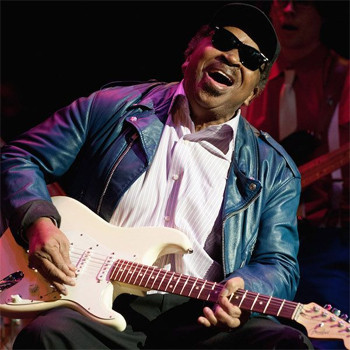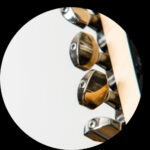Matt “Guitar” Murphy stands as a towering figure in the world of blues guitar, his name synonymous with soulful riffs and an electrifying stage presence. While many recognize him instantly from his iconic role in The Blues Brothers, Murphy’s career stretches far beyond, encompassing decades of groundbreaking contributions to blues and electric blues music. Born in Sunflower, Mississippi, on December 28, 1929, his journey took him from the vibrant Beale Street scene in Memphis to the bustling electric blues capital of Chicago, solidifying his place as a true guitar legend. This exploration delves into the life and career of Matt “Guitar” Murphy, celebrating his distinctive sound and lasting influence on generations of musicians.
From Mississippi Roots to Memphis Beale Street
Matt Murphy’s musical journey began absorbing the sounds of the Delta blues in Mississippi. He recounted being captivated by the records of blues pioneers like Petey Wheatstraw, Blind Boy Fuller, and Josh White, artists known for their intricate open string playing. However, it was T-Bone Walker who truly ignited his passion for the guitar. Murphy admired Walker’s sophisticated chord voicings, incorporating 9th and 13th chords, and his distinctive “plucking” style, a sound that resonated deeply with the young guitarist. Later, the raw and powerful styles of Albert King and Albert Collins further shaped his developing sound.
Moving to Memphis in the early 1950s, Murphy found himself immersed in a thriving music scene centered around Beale Street. This era was characterized by a fascinating duality: on one side, the sophisticated jazz of artists like Phineas Newborn Sr. and Tuff Green, and on the other, the raw, emotive blues championed by legends like Howlin’ Wolf and B.B. King. Remarkably, Matt “Guitar” Murphy effortlessly navigated both worlds, becoming one of the few musicians who could bridge this stylistic gap, playing with jazz ensembles and blues bands alike. This versatility would become a hallmark of his career.
 Matt "Guitar" Murphy performing live, showcasing his signature guitar style and stage presence.
Matt "Guitar" Murphy performing live, showcasing his signature guitar style and stage presence.
Chicago Electric Blues Pioneer
By the mid-1950s, the magnetic pull of Chicago’s burgeoning electric blues scene proved irresistible. Murphy migrated north and quickly became a vital force in shaping what we now recognize as “electric blues.” This period marked a pivotal point in blues history, with amplified instruments and urban sensibilities transforming the genre. In Chicago, Matt “Guitar” Murphy’s reputation grew as he collaborated with a pantheon of blues icons. He played alongside Memphis Slim, adding his distinctive guitar work to Slim’s sophisticated blues arrangements. His association with Howlin’ Wolf in Memphis proved formative, with Murphy even noting his role in helping Wolf refine his timing and structure within the 12-bar blues format. He further honed his skills and expanded his musical network playing with Bobby Bland, another giant of the blues world.
His Chicago years also saw him become a sought-after session guitarist for Chess Records, the legendary label that documented and propelled the electric blues sound. Murphy contributed his guitar artistry to recordings by Chuck Berry, adding his signature licks to early rock and roll history. He also played on tracks for Muddy Waters, and Sonny Boy Williamson, including the classic hit “You Gotta Help Me.” His studio work at Chess cemented his status as a first-call guitarist, admired for his inventive riffs and ability to enhance any song. Willie Dixon, the prolific songwriter and bassist for Chess, recognized Murphy’s talent, often incorporating Murphy’s guitar lines into his compositions. Murphy even recalled Dixon crediting him as a co-writer on tracks like “Every Girl I See,” later popularized by Buddy Guy and Joe Louis Walker, highlighting the collaborative and improvisational nature of the Chicago blues scene.
The Blues Brothers and Mainstream Acclaim
While deeply respected within the blues community, Matt “Guitar” Murphy achieved widespread mainstream recognition through his role as lead guitarist for The Blues Brothers band. This iconic ensemble, born from a Saturday Night Live sketch featuring Dan Aykroyd and John Belushi, brought blues music to a massive new audience. Murphy’s involvement came about serendipitously after a performance at McHale’s in New York City. His dynamic playing caught the attention of Aykroyd and Belushi, leading to an invitation to join their burgeoning musical project.
The Blues Brothers phenomenon catapulted Murphy into the global spotlight. The 1980 film “The Blues Brothers” and its soundtrack became cultural touchstones, introducing millions to classic blues and soul music. Murphy’s electrifying guitar work was a central element of the band’s sound, his solos and riffs becoming instantly recognizable. He appeared in “Blues Brothers 2000” as well, further solidifying his association with the band. Working with musical director Paul Shaffer on The Blues Brothers was a highlight for Murphy. He praised Shaffer’s musicality and arranging skills, noting their collaboration on tracks like “Bumpin the Grind, Doin’ the Nasty” and “The Blues Don’t Bother Me,” which he also recorded on his solo album. His musical partnership with fellow Blues Brothers guitarist Steve Cropper was also significant. Despite their distinct styles, Murphy and Cropper developed a strong musical rapport and personal friendship, respecting each other’s contributions to the band’s signature sound.
Guitar Gear and Signature Sound
Matt “Guitar” Murphy’s distinctive sound was shaped by his gear choices and his masterful playing technique. In his early days in Memphis, he started with a humble Harmony guitar before moving to Fender instruments in the early 1950s. His first Fender was an Esquire, which he famously carried around in a paper bag for lack of a case. He later expanded his Fender collection to include Telecasters, Stratocasters, and Jazzmasters. Gibson guitars also became a staple, particularly hollowbody models like the ES-335 and ES-345, favored for their warm tones and versatility.
For amplification, Fender amps were his consistent choice. He favored the Fender Twin Reverb and Quad Reverb for their clean power and headroom. While occasionally experimenting with effects like a phase shifter, Murphy remained primarily a “straight guitar into the amplifier guy,” emphasizing the purity of tone achieved through quality instruments and skilled playing. Later in his career, CORT Guitars collaborated with Murphy to create a signature Matt “Guitar” Murphy model. He was actively involved in the design process, ensuring it met his exacting standards for playability and tone. He praised the CORT Matt Murphy model as an “outtasight” and “GREAT guitar,” frequently playing it in his later performances, testament to its quality and his endorsement.
Legacy and Enduring Influence
Matt “Guitar” Murphy’s career is a testament to dedication, versatility, and a deep love for the blues. From his early days absorbing the sounds of Mississippi blues to becoming a linchpin of the Chicago electric blues scene and achieving global fame with The Blues Brothers, his journey is an inspiring chapter in music history. His influence extends to countless guitarists who admire his soulful phrasing, dynamic solos, and ability to seamlessly blend blues, jazz, and R&B elements. Even in later interviews, Murphy maintained a humble perspective, emphasizing the continuous learning process of music. “I’m still trying to learn how to play the guitar,” he stated, reflecting a lifelong commitment to his craft. He encouraged aspiring musicians to embrace learning and dedicate themselves to mastering their instrument, a philosophy that underpinned his own remarkable career. Matt “Guitar” Murphy’s recordings and performances continue to inspire and captivate, ensuring his legacy as a true blues guitar icon for generations to come.


